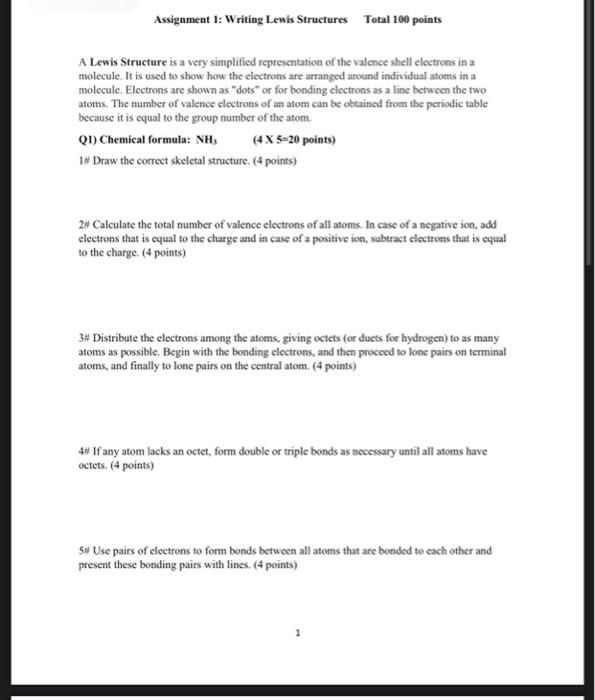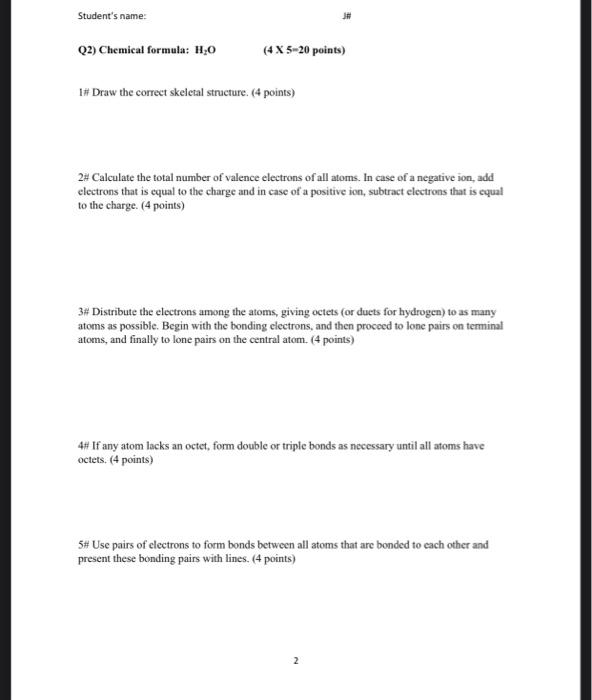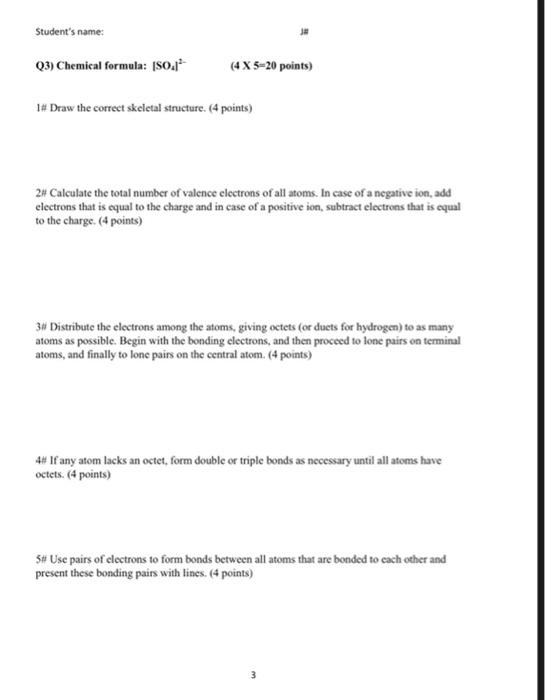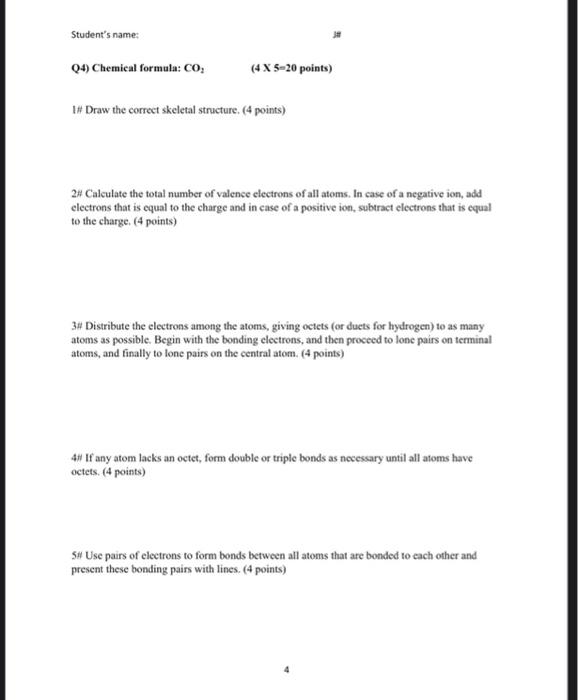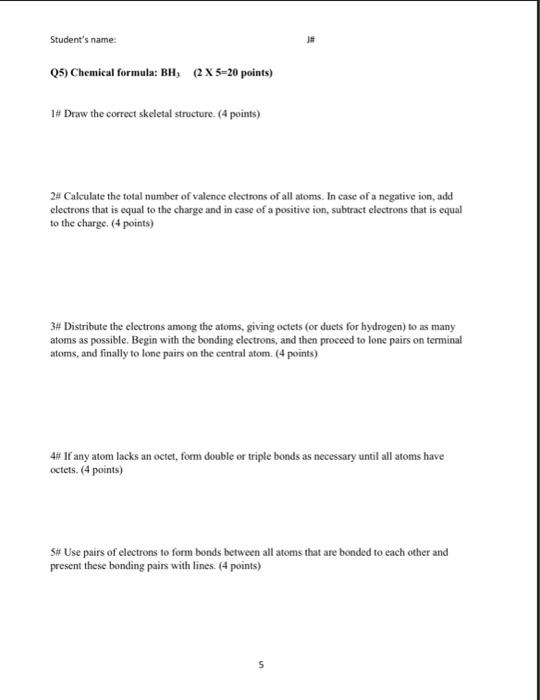Assignment 1: Writing Lewis Structures Total 100 points A Lewis Structure is a very simplified representation of the valence shell electrons in a molecule. It is used to show how the electrons are arranged around individual atoms in a molecule Electrons are shown as "dots" or for bonding electrons as a line between the two atoms. The number of valence electrons of an atom can be obtained from the periodic table because it is equal to the group number of the atom. Q1) Chemical formula: NH, (4 X 5-20 points) 1# Draw the correct skeletal structure. (4 points) 2# Calculate the total number of valence electrons of all atoms. In case of a negative ion, add electrons that is equal to the charge and in case of a positive ion, subtract electrons that is equal to the charge. (4 points) 3# Distribute the electrons among the atoms, giving octets (or duets for hydrogen) to as many atoms as possible. Begin with the bonding electrons, and then proceed to lone pairs on terminal atoms, and finally to lone pairs on the central atom. (4 points) 4# If any atom lacks an octet, form double or triple bonds as necessary until all atoms have octets. (4 points) S# Use pairs of electrons to form bonds between all atoms that are bonded to each other and present these bonding pairs with lines. (4 points) Student's name: Q2) Chemical formula: Ho (4 X 5-20 points) 1# Draw the correct skeletal structure. (4 points) 2# Calculate the total number of valence electrons of all atoms. In case of a negative ion, add electrons that is equal to the charge and in case of a positive ion, subtract electrons that is equal to the charge. (4 points) 3# Distribute the electrons among the atoms, giving octets (or duets for hydrogen) to as many atoms as possible. Begin with the bonding clectrons, and then proceed to lone pairs on terminal atoms, and finally to lone pairs on the central atom. (4 points) 4# If any atom lacks an octet, form double or triple bonds as necessary until all atoms have octets. (4 points) 5# Use pairs of electrons to form bonds between all atoms that are bonded to each other and present these bonding pairs with lines. (4 points) 2 Student's name: 03) Chemical formula: 10.1 (4 X 5-20 points) 1# Draw the correct skeletal structure. (4 points) 2# Calculate the total number of valence electrons of all atoms. In case of a negative ion, add electrons that is equal to the charge and in case of a positive ion, subtract electrons that is equal to the charge. (4 points) 38 Distribute the electrons among the atoms, giving octets (or duets for hydrogen) to as many atoms as possible. Begin with the bonding electrons, and then proceed to lone pairs on terminal atoms, and finally to lone pairs on the central atom. (4 points) 4# If any atom lacks an octet, form double or triple bonds as necessary until all atoms have octets. (4 points) 3# Use pairs of electrons to form bonds between all atoms that are bonded to each other and present these bonding pairs with lines. (4 points) 3 Student's name: Q4) Chemical formula: CO (4 X 5-20 points) 1# Draw the correct skeletal structure. (4 points) 2# Calculate the total number of valence electrons of all atoms. In case of a negative ion, add electrons that is equal to the charge and in case of a positive ion, subtract electrons that is equal to the charge. (4 points) 3# Distribute the electrons among the atoms, giving octets (or duets for hydrogen) to as many atoms as possible. Begin with the bonding electrons, and then proceed to lone pairs on terminal atoms, and finally to lone pairs on the central atom. (4 points) 4# If any atom lacks an octet, form double or triple bonds as necessary until all atoms have octets. (4 points) 5# Use pairs of electrons to form bonds between all atoms that are bonded to each other and present these bonding pairs with lines. (4 points) Student's name: (5) Chemical formula: BH; (2X5=20 points) 1# Draw the correct skeletal structure. (4 points) 2# Calculate the total number of valence electrons of all atoms. In case of a negative ion, add clectrons that is equal to the charge and in case of a positive ion, subtract electrons that is equal to the charge. (4 points) 3# Distribute the electrons among the atoms, giving octets (or duets for hydrogen) to as many atoms as possible. Begin with the bonding electrons, and then proceed to lone pairs on terminal atoms, and finally to lone pairs on the central atom. (4 points) 4# Il' any atom lacks an octet, form double or triple bonds as necessary until all atoms have octets. (4 points) S# Use pairs of electrons to form bonds between all atoms that are bonded to each other and present these bonding pairs with lines. (4 points) 5
